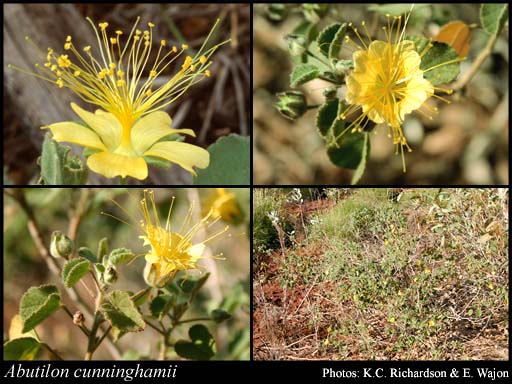- Reference
- Fl.Austral. 1:205 (1863)
- Conservation Code
- Not threatened
- Naturalised Status
- Native to Western Australia
- Name Status
- Current
Upright perennial, herb or shrub, 0.5-0.9 m high. Fl. yellow-orange, Sep to Oct. Red sand or clay.

Scientific Description
Shrub, with hairy stems. Leaves 12-55 mm long, 12-54 mm wide, not lobed; margins entire; hairy, with Simple hairs (without tubercle bases), with stellate hairswith scales absent, Sessile glands absent; stipules present but early deciduous (only visible on youngest leaves). Perianth clearly of two whorls (calyx and corolla), the corolla obvious and prominent. Pedicel present, 15-25 mm long; indumentum present, with stellate hairs present, with scales absent. Epicalyx (extra segments or 'bracteoles' immediately below the calyx) absent. Calyx green, 9-11 mm long, the lobes fused half or more of their length, Sessile glands absent, simple hairs (without tubercle bases) present, stellate hairs present, scales absent, Terminal appendages absent, number of ribs absent. Corolla yellow or orange, 20-25 mm long, glabrous, scales absent. Indumentum (outside) Sessile glands absent. Stamens many, united and arising from a staminal tube around the style; filaments present, 20-32 mm long; anthers 0.3-0.4 mm long, indumentum absent (anthers glabrous). Staminodes absent, appendages absent. Ovary hairs or scales present, simple hairs present, stellate hairs absent, gland-tipped hairs absent; style 1, 22-35 mm long, with numerous style branches or lobes, hairy for most of length, wing absent. Fruits dehiscent (capsules and follicles), length-width ratio more or less as long as wide, hairs or scales present, simple hairs (without tubercle bases) absent, stellate hairs present, Sessile glands absent, tubercle-based simple hairs absent, gland-tipped hairs absent, scales absent; apex rounded; prickles absent (except perhaps a terminal awn); terminal awns or spines absent; calyx persistent to mature fruit, not accrescent; carpels 5; seeds per loculus 1 or ≥5. Flowering time September or October. Distribution Botanical Province Eremaean, IBRA Bioregion Pilbara, Carnarvon, Gascoyne, Little Sandy Desert and Yalgoo.
Distribution
- IBRA Regions
- Carnarvon, Gascoyne, Little Sandy Desert, Pilbara, Yalgoo.
- IBRA Subregions
- Ashburton, Cape Range, Chichester, Edel, Fortescue, Hamersley, Roebourne, Rudall, Wooramel.
- IMCRA Regions
- Ningaloo, Pilbara (offshore), Shark Bay.
- Local Government Areas (LGAs)
- Ashburton, Carnarvon, East Pilbara, Exmouth, Karratha, Shark Bay.